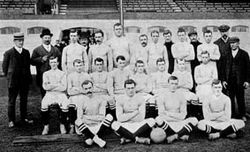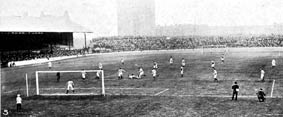History of Chelsea F.C. (1905–1952)
was founded on 10 March 1905 at The Rising Sun pub (now The Butcher's Hook),[2][3] opposite the present-day main entrance to the ground on Fulham Road, and were elected to the Football League shortly afterwards.They reached the 1915 FA Cup Final, where they lost to Sheffield United at Old Trafford, and finished third in the First Division in 1920, the club's best league campaign to that point.They failed to persuade Fulham Football Club to adopt the ground as their home after a dispute over the rent, so Mears considered selling to the Great Western Railway Company, who wanted to use the land as a coal-dumping yard.Parker later recounted what happened next: Feeling sad that the old ground would be no more, I walked slowly by his [Mears'] side when his dog, coming up from behind unobserved, bit me so severely through my cycling stockings as to draw blood freely.The utter absurdity of the remark struck me as so genuinely funny that although hopping about on one foot and feeling blood trickling down, I had to laugh heartily and tell him he was the "coolest fish" I'd ever met.The club began with established players recruited from other teams; along with Foulke, Chelsea signed forwards Jimmy Windridge and Bob McRoberts from Small Heath, and Frank Pearson from Manchester City.[18] Club secretary William Lewis took temporary charge and led the team to promotion at the end of the season, thanks largely to the goals of Windridge and George "Gatling Gun" Hilsdon.Chelsea, minus their top amateur striker, Vivian Woodward, who had sportingly insisted that the team who reached the final ought to keep their places, were seemingly unnerved by the occasion and outplayed for much of the match.Goalkeeper Jim Molyneux's mistake allowed United to score before half-time, but the Blues held out until the final six minutes, when their opponents added two more to win 3–0.With long serving mainstays including Willie Ferguson, Tommy Law and Andy Wilson, Chelsea finally reached the First Division again in 1929–30, where the club was to remain for the next 32 years.Gallacher was Chelsea's top scorer in each of his four seasons, scoring 81 goals in total, but his time in west London was hindered by his personal troubles and punctuated by long suspensions for indiscipline, including a two-month ban for swearing at a referee.The visit of Arsenal on 12 October 1935 attracted a crowd of 82,905 to Stamford Bridge, which remains a club record and the second highest ever attendance at an English league match.They also competed in the Football League War Cup, during which they made their Wembley debut, losing 1–3 to Charlton Athletic in the 1944 final, and beating Millwall 2–0 a year later in front of crowds of over 80,000.As part of a goodwill gesture, it was announced that Dynamo Moscow, reigning champions of the Soviet Union, would tour the United Kingdom and play several home teams, including Chelsea.The match took place on 13 November at Stamford Bridge with Chelsea wearing an unfamiliar red strip due to a clash with Dynamo's blue kit.After unexpectedly winning the first three, Chelsea went into their final match needing to beat Bolton Wanderers and hoping for the right result between fellow relegation candidates Everton and Sheffield Wednesday.In a bid to counter the spiraling cost of transfer fees in football, he oversaw the development of an extensive new youth and scouting programme, headed by ex-players Dickie Foss, Dick Spence and Jimmy Thompson, which would ultimately see the club produce its own players.





History of Chelsea F.C. (1952–1983)History of Chelsea F.C. (1983–2003)History of Chelsea F.C. (2003–2022)History of Chelsea F.C. (2022–present)Chelsea Football Clubassociation footballChelsea F.C.first Chelsea teamGus MearsStamford BridgeFulhamFulham F.C.ChelseaFulham Road1915 FA Cup FinalSheffield United1907–081909–101911–121912–131913–141919–20Henry Augustus "Gus" MearsJoseph MearsStamford Bridge Athletics GroundfootballFulham Football ClubGreat Western Railway CompanyboroughMetropolitan Borough of ChelsearacingLord ChelseashortsSouthern LeagueTottenham HotspurFootball LeagueWilliam "Fatty" FoulkeFA CupsJohn RobertsonJimmy WindridgeBob McRobertsSmall HeathFrank PearsonManchester CityStockport CountyLiverpoolBlackpoolSecond DivisionGlossopWilliam LewisGeorge "Gatling Gun" HilsdonDavid Calderhead1914–15FA Cup"Khaki" cup finalsoldiersOld TraffordManchesterVivian WoodwardJim MolyneuxBen WarrenBob WhittinghamManchester UnitedLondon derbyWoolwich ArsenalJack CockAston Villa1923–24Willie FergusonTommy LawAndy Wilson1929–30ArgentinaHughie GallacherAlex JacksonAlec Cheyne1926–27Wembley WizardsSunderlandLondonSheffield WednesdayTommy LangLeslie KnightonSam WeaverSid BishopHarry BurgessDick SpenceJoe BambrickVic WoodleyGeorge Mills1932–331933–341938–39Grimsby TownQueens Park RangersBilly BirrellArts et Techniques dans la Vie moderneAustria WienBolognaSlavia Prague1939–40Matt BusbyWalter WinterbottomEddie HapgoodFootball League War CupWembleylosing 1–3Charlton AthleticMillwall2–0 a year laterJohn HarrisGeorge VIgoodwillDynamo MoscowTommy LawtonLen GouldenTommy Walker1946–47Notts CountyRoy BentleyNewcastle UnitedWhite Hart LaneA year laterBolton WanderersEvertongoal average